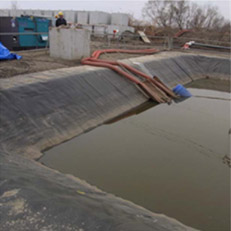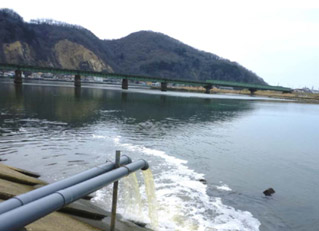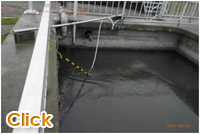Great East Japan Earthquake Strikes Sewerage System
Takeshi Yamauchi
4. Impact on the Environment
4.1 Emergency Treatment of Waste Water
Sewerage systems were severely damaged in the earthquake, and systems lost much of their functions. Pipes and pump stations were damaged, so waste water from cities could not flow down to waste water treatment plants. Waste water treatment plants could not perform their treatment because their machines and electrical connections were shut down. Many related facilities are forced to take emergency counter-measures.
-
- Emergency counter-measure in waste water treatment plants
-
Because pumps in waste water treatment plants were broken by tsunami, temporary pumps were needed to send raw waste water to treatment plants. However, 12 plants were damaged so severely that they could not perform their ordinary treatments. Thus, for the emergency treatment, only primary sedimentation and chlorination are performed.
-
- Emergency counter-measure in pump stations and main pipes
-
Emergency treatments were performed and then discharged into water bodies in some main pipes and pump stations. This is due to the breakage of waste water treatment plants, or the damage of downstream pipes. Extra caution is needed when discharging waste water at pump stations and main pipes because these pump stations and main pipes are usually located at upstream. Situation of the downstream area must be researched before discharging the waste water.

Figure 12.(a) Performing primary sedimentation and chlorination(21)

Figure 12.(b) Discharging treated waste water to Kitagami River, Miyagi(21)
4.2 Quality of Discharged Water
Because waste water is discharged without ordinary treatments, its quality must be carefully observed. Table 5. is environmental quality standards imposed by the Water Pollution Prevention Act.
| unit | Environmental quality standards river | Environmental quality standards ocean | |
|---|---|---|---|
| BOD | mg/L | ≦1 to 10 | - |
| COD | mg/L | - | ≦2 to 8 |
| pH | - | 6.0 to 8.5 | 7.0 to 8.3 |
| SS | mg/L | ≦25 to 100 | - |
| Coliform | MPN/100mL | ≦50 to 5,000 | ≦1000 |
| Date researched | BOD | COD | pH | SS | Number of E.coli | |
|---|---|---|---|---|---|---|
| Fujiwara River | 28-May-11 | 1.4 | - | 7.4 | 8 | 130,000 |
| Date researched | BOD | COD | pH | SS | Number of Coliforms | |
|---|---|---|---|---|---|---|
| Sennen Purification Center | 20-May-11 | 120 | 70 | 6.7 | 51 | 980,000 |
Table 5 and table 6 show the quality of treated waste water from Sennen Purification Center, and the quality of water from Fujiwara River. A measured number of coliforms in the treated waste water discharged from Sennen Purification Center were 980,000. This number will not satisfy the environmental standards if the treated waste water would not be diluted thousand times. Thus, quality of the river water after the treated waste water from Sennen Purification Center was discharged may not have satisfied the environmental standards. As for Fujiwara River, river in Fukushima, quality of its water was satisfying the environmental standards for last three years, so it may be possible that raw waste water was discharged into the river. (24) Emergency treatment needs to be brought up to higher level of treatments.




